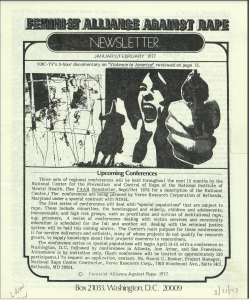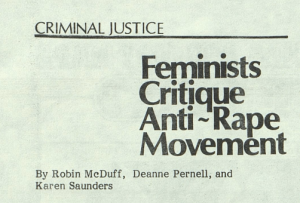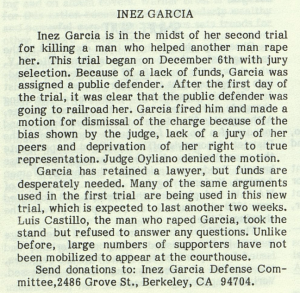
The cover of the January/February 1977 issue of the Feminist Alliance Against Rape Newsletter.
The Feminist Alliance Against Rape Newsletter began in 1974, turning out monthly issues with resources and opinion pieces aimed at combatting rape and rape culture. The issues both suggest new ideas and critique flaws in the entire anti-rape movement. The January/February 1977 issue is particularly poignant. The issue focuses on the problematic nature of the criminal justice system and the police being the first place victims of assault are told to go for help. It seeks to explain why this encouragement to always go to the police is not necessarily beneficial to the movement or to victims and further attempts to provide alternative resources for victims.
The layout of the issue is simple; it does not seek to draw any reader in who does not wish to use its resources. Its simplicity is highlighted especially through the cover. The editors chose to use black and white text, an image of a documentary it will review, and text explaining upcoming conferences. The cover thus jumps right into the content of the newsletter. So, logically, the only people who are going to be drawn to the newsletter are those in need of resources who are looking for it; the newsletter does not want to attract masses of people, necessarily, but rather seeks to be a resource for victims who need it and allies/feminists who want to engage with the movement more intentionally.
 The first piece in the newsletter is “Feminists Critique Anti-Rape Movement,” by Robin McDuff, Deanne Pernell, and Karen Saunders. The bolded font is eye-catching, as is the title. The idea of a publication, focused on fighting rape and rape culture, critiquing the very movement it is a part of is a daring way to begin the publication; it draws the reader in intentionally. The newsletter has already targeted a very specific demographic, victims and allies, with its cover and so the daring first piece serves to keep that demographic engaged. The focus of the article, explicitly in an open letter format to the entire anti-rape movement, is to “address the issue of the relationship of the anti-rape movement to the criminal justice system” (McDuff). The reason the authors see this relationship, one which encourages women to immediately go to the police when they have been assaulted, as problematic is because it is often the only option presented to victims. The authors clarify that they “support the right of individual rape victims to go through the criminal justice systems,” but specifically dislike the idea of a woman being “forced to do anything” in regards to her deeply personal experience with sexual assault (McDuff). So, their first issue with the criminal justice system is that it seems to be the only resource available to women. Furthermore, they claim that the overall “sexist and racist nature of the criminal justice system only makes the problem [of rape] worse, citing “hostile” and unsupportive” treatment of rape victims by the system (McDuff). In addition, the authors frame the criminal justice system as taking the power over her experience away from the victim as well as often failing to convict rapists even when women come forward. So, part of the way The Feminist Alliance Against Rape Newsletter seeks to further the fight against rape culture is through identifying parts of the movement that can be worked on in order to make it stronger and more supportive for victims as a whole.
The first piece in the newsletter is “Feminists Critique Anti-Rape Movement,” by Robin McDuff, Deanne Pernell, and Karen Saunders. The bolded font is eye-catching, as is the title. The idea of a publication, focused on fighting rape and rape culture, critiquing the very movement it is a part of is a daring way to begin the publication; it draws the reader in intentionally. The newsletter has already targeted a very specific demographic, victims and allies, with its cover and so the daring first piece serves to keep that demographic engaged. The focus of the article, explicitly in an open letter format to the entire anti-rape movement, is to “address the issue of the relationship of the anti-rape movement to the criminal justice system” (McDuff). The reason the authors see this relationship, one which encourages women to immediately go to the police when they have been assaulted, as problematic is because it is often the only option presented to victims. The authors clarify that they “support the right of individual rape victims to go through the criminal justice systems,” but specifically dislike the idea of a woman being “forced to do anything” in regards to her deeply personal experience with sexual assault (McDuff). So, their first issue with the criminal justice system is that it seems to be the only resource available to women. Furthermore, they claim that the overall “sexist and racist nature of the criminal justice system only makes the problem [of rape] worse, citing “hostile” and unsupportive” treatment of rape victims by the system (McDuff). In addition, the authors frame the criminal justice system as taking the power over her experience away from the victim as well as often failing to convict rapists even when women come forward. So, part of the way The Feminist Alliance Against Rape Newsletter seeks to further the fight against rape culture is through identifying parts of the movement that can be worked on in order to make it stronger and more supportive for victims as a whole.

An advertisement for Inez Garcia found within the newsletter.
The issue further provides examples of the corruption of the criminal justice system. It includes the stories of women who are on trial or in prison for killing or injuring their abusers/rapists. Each story is also an advertisement because it tells the reader how to donate to the cause of helping the woman affected. An example of such a story is that of Inez Garcia, a woman “in the midst of her second trial for killing a man who helped another man rape her” (The Feminist Alliance Against Rape newsletter). This inclusion is relevant because it highlights the hypocrisy of the criminal justice system which is willing to punish women for fighting back but not willing to punish rapists. It also tells the reader how to help, giving specific calls to action to fight rape culture on an individual basis.

This is an advertisement for “Nutcracker Suite” found within the Feminist Alliance Against Rape Newsletter. This advertisement is another example of the resources the newsletter provides.
Furthermore, the newsletter provides concrete resources for victims and potential victims of sexual assault. For example, it includes an advertisement for the self-defense school’s “summer training program for women” (Feminist Alliance Against Rape Newsletter). The inclusion of resources such as the self-defense class is important because it means that the newsletter not only critiques the idea of the criminal justice system being the only resource offered to victims but also offers alternative resources. This backs up the earlier point that the anti-rape movement can and should move away from the criminal justice system as its go-to resource. The Feminist Alliance Against Rape Newsletter pushes back against rape culture in that it focuses on building the movement in new and innovative ways. The editors look at the big picture of the movement and include both theoretical critiques and concrete, action-driven ideas and resources. The newsletter thus serves to create both short-term and long-term change within the movement.
Sources:
Feminist Alliance Against Rape Newsletter, May 1997.
